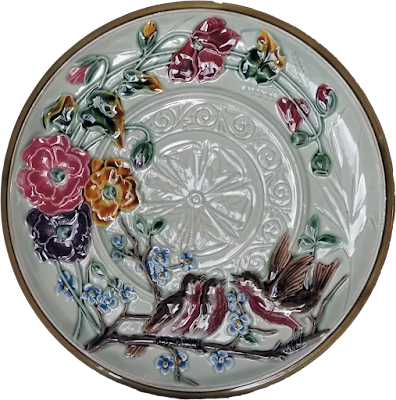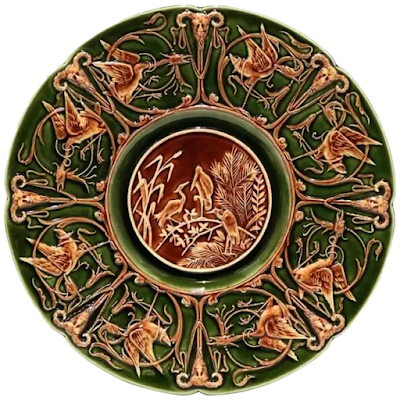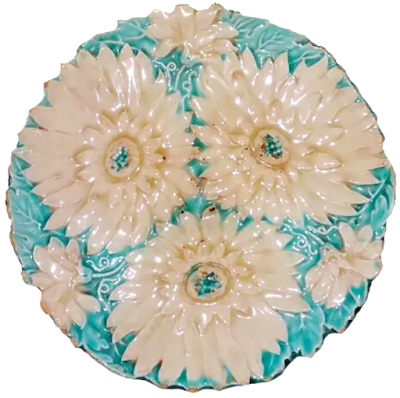Schütz majolica is not well known in the United States by name but there are very few collectors who have not encountered some of their output. In spite of their excellent craftsmanship, the companys' work has been largely overlooked for over a hundred years. The Schütz potteries have a history that is an interesting and complex one involving two brothers who operated together then separately under connected potteries with similar products under similar names. Complicating things are the intricate politics of the area with shifting country borders after WW1 adding to difficulty between the connected potteries and their adjoining countries. What can be said is that among the larger potteries in Bohemia they employed up to 200 workers at their peak.
The pottery was originally established by Peter Eugen Selb and Carl Gustav Lenk in Olomuczany near Blansko and the large city of Brno along the Morava River in 1849. Purchased in 1854 by Karl Schütz the pottery that was to become Gebrüder Schütz Handelsgesellschaft was expanded and then trusted to his sons Ludwig and Arnold in 1860 for their management. Ludwig was a chemist and technical engineer while Arnold was a lawyer. The company took on the trade name Gebrüder Schütz Blansko.
They specialized in kitchenware and decorative hand painted earthenware. In time they expanded to more decorative housewares, brick, stoves and majolica. Around 1860 the company purchased a second facility in Petrovče near Cilli, then in a Provence of Austria called Styria—now Celje in Slovenia—in which they developed finer wares that had them competing, and winning, in major exhibitions throughout central Europe. This second plant took the name of Schütz Cilli.
The brothers Schütz operated the companies together for 30 years under the names Gebrüder Schütz, Schütz Blansko and Schütz Cilli with Arnold managing the main plant in Olomuczany while Ludwig operated the branch plant near Cilli. In 1890 the companies split due to inheritance reasons with Arnold Schütz remaining in Olomuczany with Schütz Blansko and Ludwig Schütz operating Schütz Cilli in the facility at Petrovëc, Liboje. Cilli was the larger and more profitable facility though they continued sharing materials, glazes, clays, forms and designs. An additional smaller facility in Griźe was purchased in 1894.
Eight years after the split between the Schütz potteries, Arnold handed over management of Schütz Blansko to his son-in-law Wilhelm Julinek who sold the property to Oskar Basch. By 1906 the pottery was operating under a partnership including Basch, Emil Mandl and Franz and Wilhelm Julinek. The pottery ceased production of household ceramics and concentrated instead on the production of tile, brick and pipes for construction. The business closed in 1922.
The Schütz Cilli facility in Liboje then changed names a couple of times—both incorporating Ludwig’s name. Ludwig expanded the branch plant while producing a wide range of household wares and majolica until his retirement in 1906. He then handed over management of the company to his daughter Maria Charlotte. She ran it until 1917 when it was forced to close from the general ravages of WW1–a lack of manpower and an inability to access materials. Ludwig died two years later and the factory was sold in 1922 to the Abel family. Maria lived another 24 years dying in 1946 in Merano, South Tyrol, Italy.
Schütz Cilli majolica charger
The Abel family continued production under the name Majolika Celeja using some of the old majolica molds. The company was nationalized in 1946 with the new name Keramična Industrija Liboje.
Marks
There were several marks used by the Schütz factories. Pieces only stamped with the circular mark of a kneeling archer inside a G are often attributed to Gebrüder Schütz (Schütz Brothers) or Schütz Blansko with pieces specifically stamped Gebrüder Schütz considered older. Because of the split between the brother's families it is sometimes difficult to date Schütz Blansko or Schütz Cilli pieces to before or after 1890 due to the fact that both marks were in use from 1870 forward until the closing of the companies. To complicate matters the two companies shared each other’s molds so a piece with the same design could be by either Schütz Blansko or Schütz Cilli. In auction listings it is common to see both Schütz Blansko and Schütz Cilli attributed to Gebrüder Schütz. Production numbers impressed on the back of each piece may be a way of identifying the design date but to the best of my knowledge these records have remained in private hands and are not available to the public.
The best way to date pieces made after the split is by the addition of other marks on the base of the ware. Although Schütz Blansko used the archer mark from 1859 to 1906, ware intended for export had to also have the country of origin stamped on the ware after 1890. Schütz Blansko pieces marked Austria or Made in Austria can reliably be attributed to after that date. The same is true for Schütz Cilli which used two marks, one impressed and one ink stamped, both which included country of origin after 1890.
Schütz majolica is usually easy to find though it may not be identified as such. Gebrüder Schütz, Schütz Blansko and Schütz Cilli usually bring similar prices with dealers rarely differentiating between the three. Prices also tend to be reasonable for the most part with only the elaborate hollowware and decorative chargers commanding high prices.
If you would like further information about Schütz Cilli, a comprehensive new book is available, in German and Slovenian through Pavel House, by Austrian author and collector Wilfried Gombocz, a relative of the Schütz family.


























































